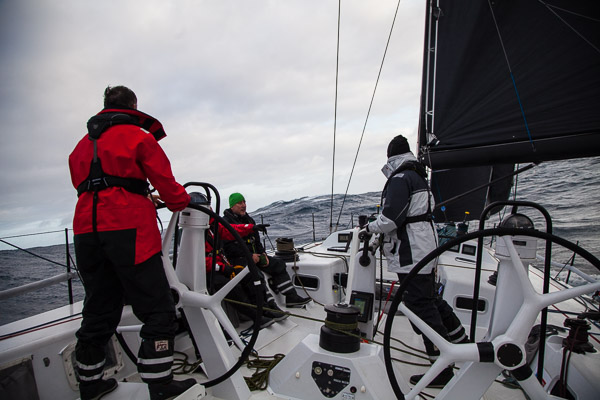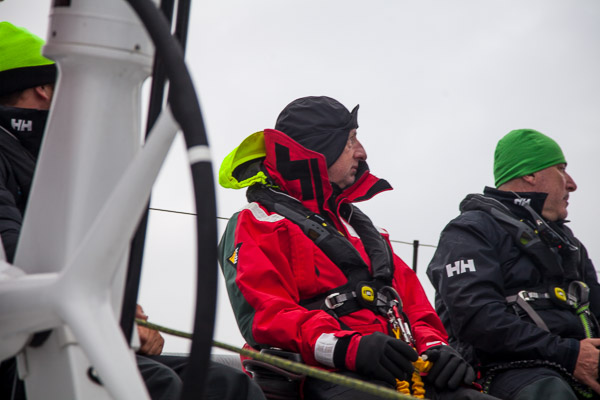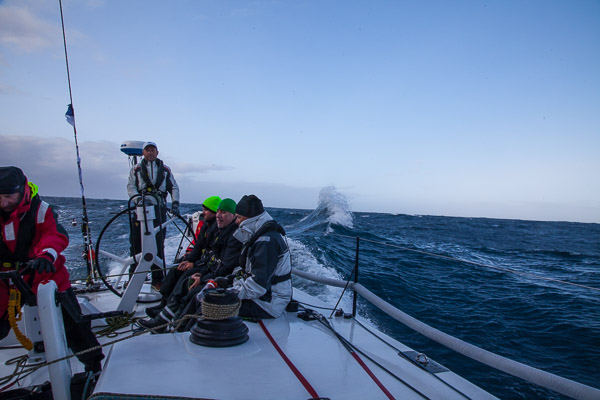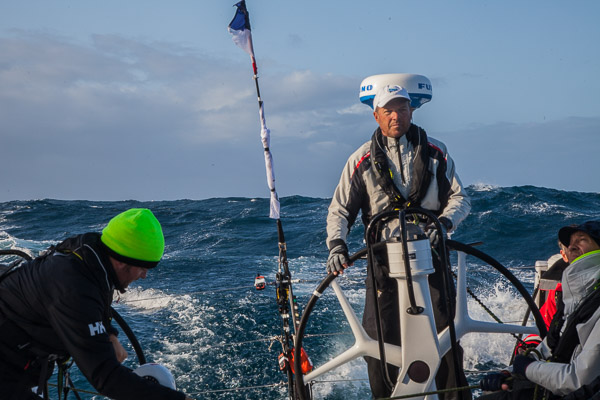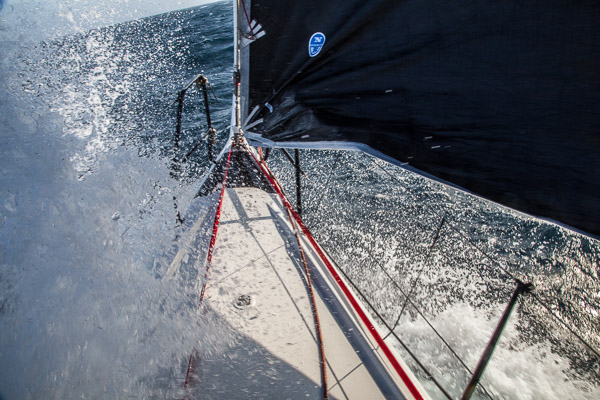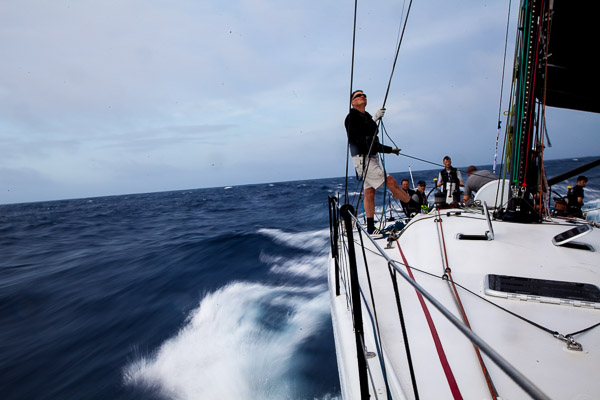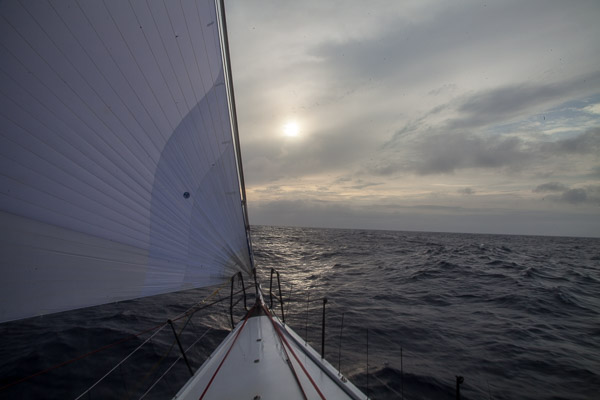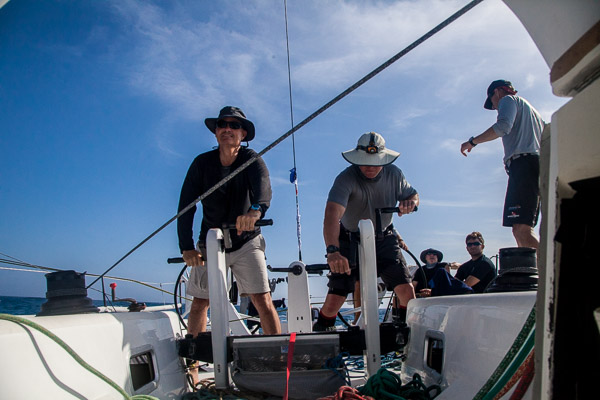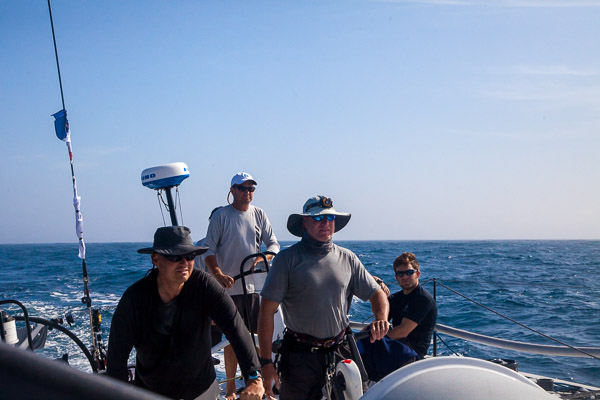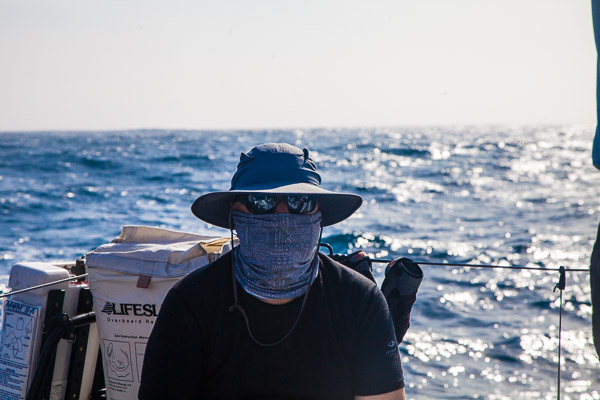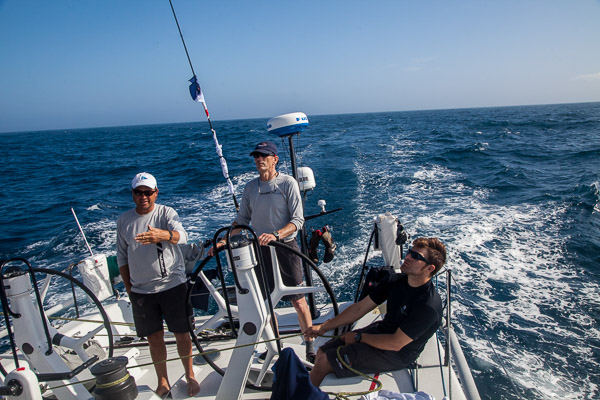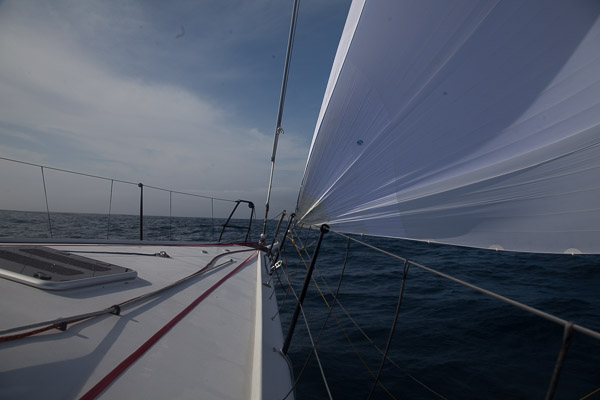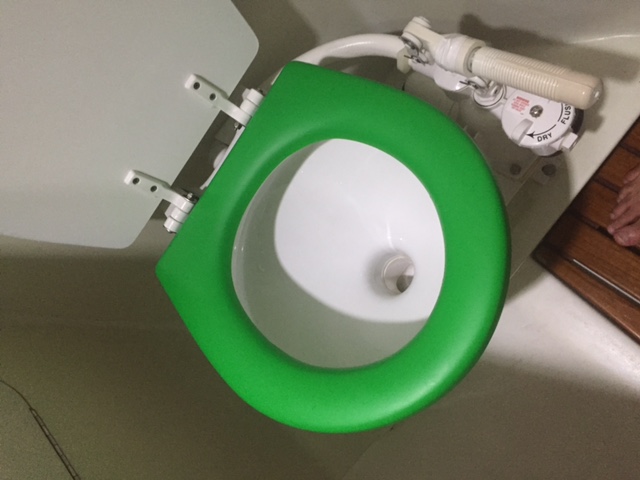Poking The Bear
I has been quite a day on Prospector. After blinking twice on two
attempts to sail to the southern edge of the big low pressure system
pacing us to the northwest, at 0430Z, lifted by a right shift, we began to
discuss gybing and trying again. Larry, Paul and Terry huddled and
discussed the pros and cons of the move. They decided to go for it.
But, Paul had one condition, if we gybed Larry couldn’t change his mind
and want to gybe back again in 15 minutes. Paul knows Larry has a
tendency toward gyber’s remorse. Larry agreed and said he would go
take a nap to avoid the temptation. The order was given and we gybed
to a northerly heading and started sailing toward the low again. Before
climbing in to his bunk Larry took a quick peek at his nav screens and
immediately was happy with the decision.
This practice of sailing toward the big low is now universally referred to
by the crew as Larry poking the bear. For what it is worth Larry doesn’t
really want to poke the bear. Expedition, our navigation and routing
software does. Larry is just Expedition’s spokesperson. For the last 36
hours every route Larry has run on Expedition has called for an
immediate gybe to the north. He has tried every trick that Peter Isler
and Chris Bedford have taught him to convince the software otherwise,
but it is adamant about the gybe. That is why we have been looking for
every opportunity do so.
After the gybe with our go to sail combination of a reefed main, J4 and
Genoa Staysail, we were off to the north and sailing fast. We awoke to
an unexpectedly beautiful morning. It was warm and sunny. The crew
enjoyed their morning coffee and oatmeal breakfast on deck and
everyone took turns driving Prospector in terrific sailing conditions.
Henry, gave Larry a new nickname, Longboard Larry, because he was
having so much fun surfing the big sixty footer in mid 20 knot winds and
a huge following sea. Matthew busied himself taking photos and
videos for us to post later. Some of the photos will go up tonight. The
video will need to wait for us to have a faster, cheaper internet
connection than our FB150.
Larry turned the helm over to Paul, and went to do his thing at the Nav
station. We were still 36 miles from where we thought the southern
edge of the low was, but the wind suddenly jumped to 30 knots, the
limit we had set for our proximity to the low. It was time to gybe back.
Tery and Quinn quarterbacked prepping for the gybe, something not to
take lightly in such strong winds and high seas. They began by putting
in a second reef assisted by Matthew and Andrew at the mast, Lucien
and Scotty at the pit and Tim, and Dave in the cockpit. Paul manned
the helm with Henry assisting by calling the waves. The reef complete
Bruce and Matthew went to the bow and struck the Genoa staysail. We
were getting ready to gybe when the wind jumped to 42 knots, making
gybing too dangerous. Tery decided it was safer to do a chicken gybe,
performing a 360 degree turn to a tack, rather than a straight gybe.
The only problem with the chicken gybe being the risk of stalling the
boat and getting stuck dead in the water in high winds and a big sea.
Completing the maneuver involved turning Prospector very quickly and
backing the jib to pull the bow around, which with Paul on the helm
and Tery on the jib, was executed perfectly.
The chicken gybe completed we immediately put in a third reef in 40
knot plus winds. Now sailing in a triple reefed main and just the J4 and
a strong following sea, we were pointing straight at the finish line and
going very fast. The only issues were the waves and the weather.
The waves had become bigger than ever, and made driving very
challenging. The weather was complicated too. We were sailing with
the low to our left, the warm front ahead of the low just ahead of us
and the cold front trailing the low just behind us. You could see these
features very easily and didn’t need a weather map to figure them out.
Squalls were popping up and tracking from southeast to northwest
along the leading edge of the cold front.
We were not in any danger, but were facing very technical and
challenging sailing conditions. Our ace in the hole was Prospector
herself. Flat and stable, she reveled in the conditions. Her helm was
balanced, she tracked straight and smoothly and she responded
beautifully to each course adjustment.
The Prospector crew, a terrific bunch of sailors, was also up to the
challenge. We shortened the driving rotation, normally shared evenly
by all, to Tery, Paul, Henry and Tim. Larry went to the nav station to
learn how to track the squalls on radar, something he had never done
before, assisted by Jeff. Colette made sandwiches to keep the crew
fueled up. Brendan called waves. Scotty repaired a torn batten pocket
on the GS. Matthew, Lucien, Bruce, Dave and Andrew trimmed sails.
We adjusted the watch schedule to reflect the new rotation and began
rotating people below decks to get some sleep.
Everything well under control we began to put up some big numbers in
a steady 35-38 knot, with low 40 knot gusts, southwesterly wind. As
the sun set, we struck the J4 and put up the J5, our smallest headsail in
30 knot winds. Quinn has a nickname for each of our sails. He calls the
J5 the Lindsay Vonn, because it is beautiful, tough and always comes
through in the clutch. The winds and sea are forecast to settle down
over night, but we are trying to be as conservative possible as we sail
on in a very dark, still very windy night in a pretty tossed up ocean.
So, why did we really poke the bear? It wasn’t all about the routing.
We wanted to sail left to take advantage of an expected left shift over
the course of tomorrow. Also, given the loss of two kites we can’t go
toe to toe in a downwind VMG race, particularly with Snow Lion and to
a lesser extent with Maximizer. Nomad IV is so big she poses a whole
different set of challenges. What we have learned over the past few
days is that Prospector loves pressure. The more the better. We have
also learned that we can sail as fast, and perhaps safer in a big breeze,
with a reefed main, the J4 and a Genoa staysail than we could have
sailed with the A6 we no longer have available. The track we are on is
forecast to have consistent 30 knot winds for the next 8-10 hours
followed by 25-30 knot winds for the 18-20 hours after that. The winds
on the track we left are forecast to be much lower.
We gained ground quickly today on the two yachts in front of us, Snow
Lion and Maximizer. We are now second in our class and sixth in our
fleet. We have sailed 1,858 nautical miles in just over six days since we
started. We have 1,242 nautical miles to go to our finish at the Lizard in
Cornwall, England. A lot can still happen, both good and bad. We have
a nice little race going and are looking at a potential podium finish in
our class and top ten finish in our fleet. Both outcomes are well beyond
our most optimistic hope when we began this adventure. We are
proud of what we and Prospector, more to come on the mighty
Prospector in a future post, have done so far and very aware of and
focused on what we still have to do.

